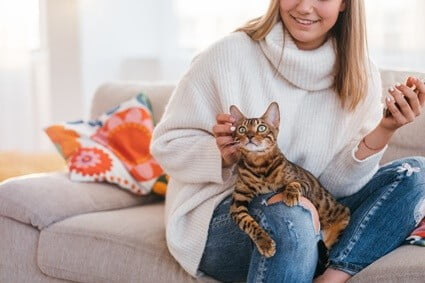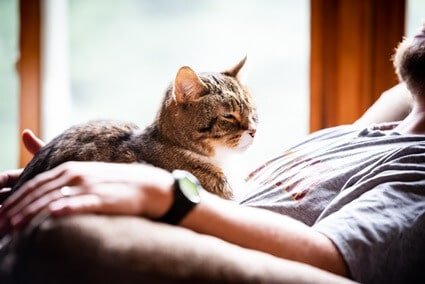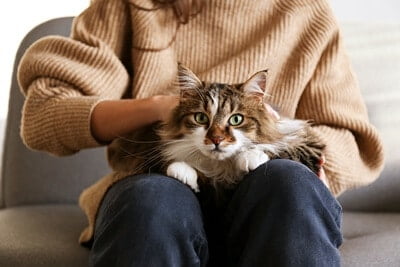The pinnacle of ownership comes when your cat sits on your lap. Not all cats do this, but when they do, it’s a special moment to cherish.
Cats sit on people’s laps because they enjoy the warmth. Despite having fur, their body temperature exceeds ours so that they can tolerate higher heat levels. Cats also enjoy the comfort and safety that sitting on a lap provides. When a cat sits on you, it means it trusts you. Cats are also encouraged by their owners’ scents, affection, and the feeling of comfortable clothes. Sitting on a lap also calms and soothes anxious cats.
Never force your cat to sit on your lap or make it stay there if it wants to get down. This will damage the trust your cat has in you and make it feel stressed.
What Is the Meaning of Lap Cats?
A lap cat is a cat that enjoys sitting on its owner’s lap. The important thing is it does so willingly and without pressure. If a cat is forced to sit on a lap, it’s not a true lap cat and will likely jump down when it gets a chance.
Why Do Cats Like Laps So Much?
When cats settle down on their owners’ laps, they stay there for hours. Not all cats sit on laps, but this behavior is part of what makes feline ownership so special. There are several reasons why cats like laps so much, including:
Warmth
Cats are descendants of desert animals, so they’re drawn to warmth. Even though they have fur coats, they thrive when they’re warm. Their body temperature ranges from 100.5 to 102.5 degrees, with 101.5 being the average. This means they have a higher tolerance to heat and enjoy curling up on a warm lap.
Safety
Some cats feel safer when they’re close to their owners. According to a study published by Current Biology, researchers found that cats develop strong bonds with their owners, becoming less stressed as soon as they walk into a room. Cats that form these strong attachments enjoy being around their owners, and a lap is the most secure place for them.
Affection
Cats that feel bonded with their owners seek affection and attention from them. Curling up on a lap is the prime spot to be petted and cuddled, which many cats enjoy. It feels most pleasant under the chin, behind the ears, and along their back, so focus on touching these spots whenever you stroke your cat when it’s sitting on your lap.
Trust
It’s the ultimate sign of trust when your cat sits in your lap. Sleeping makes cats vulnerable because it’s the time they’re most likely to be attacked. It also means cats trust you enough to protect them from dangers. To build trust, never force your cat onto your lap – wait until it chooses to curl up on you. That way, you’ll know your pet’s truly happy.
Smell and Sound
Natural human noises and motions, such as breathing and heartbeats, are relaxing and soothing to cats, helping them sleep. You also have a unique smell, which cats can pick up on. This is a type of safety blanket for your cat, allowing it to settle down and rest.
Comfortable Clothes
If your cat sits on your lap when you wear certain clothes, it’s likely sitting on you because it likes the way they feel. Textures such as fleece and toweled bathrobes are warm and comfortable and provide the mental enrichment that cats need to thrive.
Calms Anxiety
If you have an anxious cat, sitting on your lap can calm its nerves and help soothe it to sleep. Some cats are naturally more anxious than others, which could be a result of their past. However, they tend to build trust with only one person, refusing to sit on anyone else’s lap.

Why Does My Cat Sit on My Partner but Not on Me?
Cats often form attachments with particular people, and it’s usually with those who feed them and give them the most attention. Cats prefer people who don’t force them to sit on their laps and provide them with the space they need. There’s a fine line between providing your cat with too much attention and too little, and you should think about which side you fall on.
Similarly, if you move around too much or are noisier than your partner, your cat will likely sit on them over you. According to VCA Hospitals, cats have between 45 to 80 million scent receptors. This means they can distinguish between your scents and your partner’s scents. Your cat may sit on your partner because it prefers their scent.
Why Won’t My Cat Sit on My Lap Anymore?
If something’s recently changed within your cat’s environment, it may feel too stressed or anxious to sit on your lap. This is potentially be caused by:
- A new pet
- The arrival of a baby
- A recent house move
Similarly, if you’ve recently disciplined or shouted at your cat, it may have developed a fear of you, losing the trust it once had to sit on your lap. Cats will stay away if they sense a threat, so it’ll take a lot of work to regain your pet’s trust before it sits on your lap again.
Unfortunately, cats will also stay away from you if you accidentally hurt them – by standing on their tail, for example. Hopefully, with time, your cat will be comfortable enough to sit on your lap again.
My Cat Sits Next to Me but Not on My Lap
Just because your cat doesn’t sit on your lap doesn’t mean it doesn’t want to be near you. Some cats aren’t naturally drawn to human laps and prefer to find comfort somewhere nearby. Being next to you provides the same amount of safety, affection, and trust that sitting on a lap provides.
Shy, timid cats are less likely to sit on your lap. The same goes for cats that don’t enjoy being stroked or petted too often.
Why Do Some Cats Not Like to Sit on Laps?
It’s a privilege when cats choose to sit on their owners’ laps. Unfortunately, this means that not all cats are destined to be lap cats. Don’t take this personally – you can still build a bond with your cat; it just means you’ll have to find other ways of enjoying its company. Here are the most common reasons why can’t don’t like to sit on laps:
Age
Cats adopted as adults are far less likely to sit on their owner’s lap, especially if they’ve had a traumatic past or previously lived on the streets. Kittens are easier to train and socialize, but many older cats prefer to keep their distance and enjoy human company from afar.
This isn’t to say you can’t train a mature cat to sit on your lap, but it’ll take time, effort, and lots of patience before it thinks about it.
Personality
Cats aren’t hard-wired to sit on laps – it all comes down to their personality. There may not be a specific reason why your cat doesn’t sit on yours, it’s just the way your pet is. Some cats become more affectionate as they get older and become lap cats, but this isn’t guaranteed. Enjoy your cat and its quirks without forcing it to sit on you.
Other Pets
When there are other pets in the house, cats may feel too threatened to sit on your lap. Not all pets get on well with each other. Animals can become jealous if they think they have to “share” their owners. Dogs, in particular, warn cats off their humans by becoming aggressive. They also bark and growl to scare cats away. In this case, it’s not that your cat doesn’t want to sit on your lap – it’s simply too much of a risk to do so.
Rough Handling
Be careful how you handle and pet your cat. If you’re too rough or cause your cat stress when you touch it, your pet will stay away. You may not realize that you’re being too rough, but your cat will avoid you and refuse to sit on your lap.
What Cats Make Good Lap Cats?
If you’re looking to get an affectionate cat, you’ll want to know: what are the best lap cats? There are several breeds to choose from, including:
Ragdoll
Ragdolls are laidback and specifically bred to be affectionate cats. They’re famous for going floppy when they’re picked up and cuddled, making them popular pets.
Siamese
Siamese cats are sociable animals that enjoy spending time with their owners. They crave companionship and are happy to sit on their owners’ laps for hours.
Main Coon
Main Coons are known as family cats. They enjoy being around their people and follow them around, displaying a friendly temperament and enjoyment of cuddles.
Scottish Fold
Scottish Folds are charming, easy-going cats that are more than happy to curl up on their owners’ laps. They don’t like being outside. Instead, they prefer to stay inside with their family.
Persian
Persian cats are one of the most sweet-natured and docile cat breeds around. They’re not very active, and they need to be kept indoors, so they’re more than happy to chill out of your lap.
Birman
Birman cats aren’t as well-known as some of the other breeds on our list, but they are loving companion cats. They’re very people-orientated and love to be cuddled and held like a baby.

Tonkinese
Tonkinese cats are closely related to the Siamese. They’re friendly and affectionate, making them excellent family pets. They need companionship and demand a lot of attention, so they make perfect lap cats.
Russian Blue
Russian Blues are affectionate, but they’re not clingy. They’re often shy at first, coming out of their shell once they get to know their family. They’re great at reading human emotions and cuddle up to their owners when they’re sad.
Bombay
Bombay cats are happy to watch the world go by from their owners’ laps. They love as much attention as they can get, so a lap’s the perfect place to receive it.
Sphynx
Sphynxes make cuddly, affectionate pets and demand attention. They don’t like being alone – they’re happiest having people around them for cuddles and petting sessions.
How To Turn Your Cat into a Lap Cat
With a little training, you may be able to get your cat to sit on you. As mentioned, start as early as possible if you can, as it’s easier to encourage a kitten to become a lap cat than a mature, established cat. Follow these steps to get your get to sit on you:
- Start by being as quiet and calm as possible so that you don’t spook your cat.
- Handle your cat as much as possible, being kind and gentle when you do.
- Use positive reinforcement training with treats to get your cat to move closer.
- Place a blanket your cat sleeps on next to you. The scent should entice your pet to go near you.
- Once your cat sits on your lap, don’t give it too much fuss, or it may jump down.
Keep repeating these steps, as consistency is the best way to get your cat to sit on your lap. Never force your cat, however, and if it seems uncomfortable, abandon the training.
Don’t be disheartened if your cat never sits on your lap. Some cats do automatically, while others never get into the habit. Giving your cat plenty of cuddles and attention can help.

